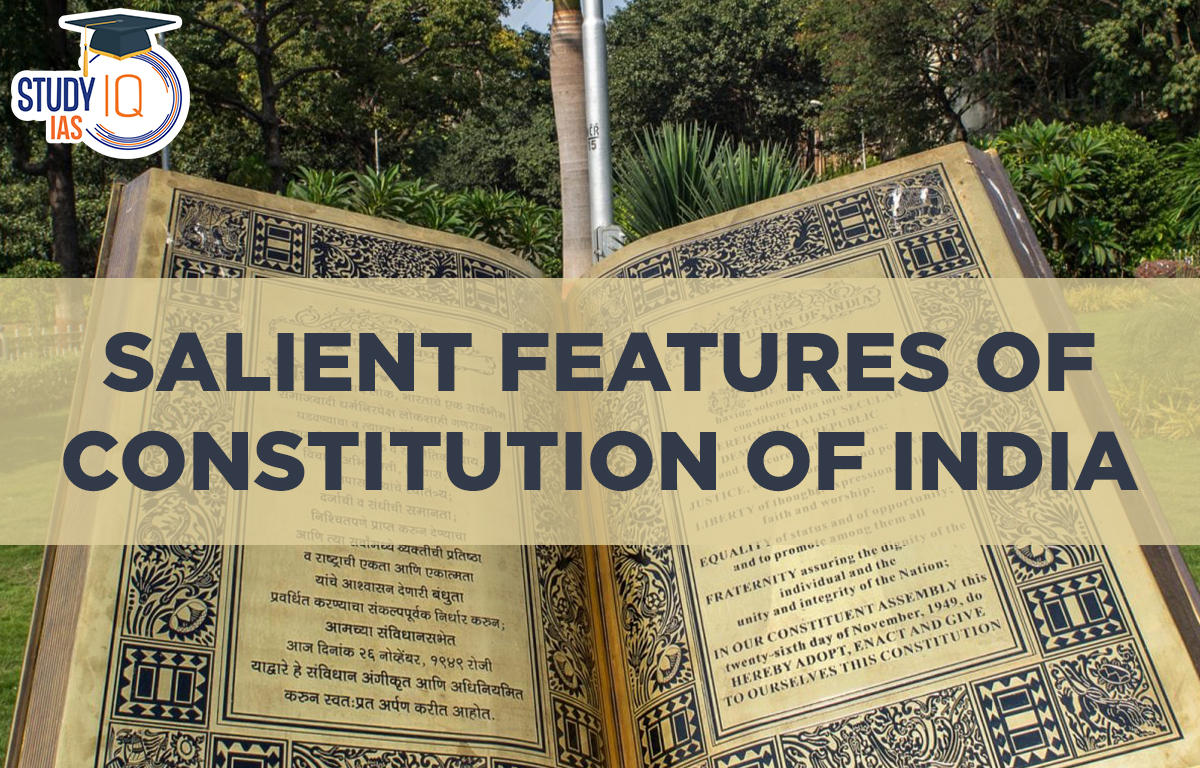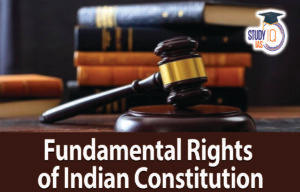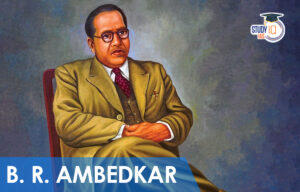Table of Contents
Salient Features of Indian Constitution
Salient Features of Constitution of India: The Indian Constitution opens with a preamble. The Constitution’s aims, goals, and fundamental precepts are outlined in the Preamble. These goals, which follow from the Preamble, have directly and indirectly influenced the Constitution’s key elements.
According to the nation’s requirements, our Constitution has incorporated the best elements of most major international constitutions. Despite including elements from nearly every Constitution in the world, India’s Constitution stands out from those of other nations due to a number of key characteristics.
List of Salient Features of Indian Constitution
The Indian Constitution is the supreme law of the land and lays down the framework defining fundamental political principles, establishes the structure, procedures, powers, and duties of government institutions, and sets out fundamental rights, directive principles of state policy, and the duties of citizens. Here’s the complete List of Salient Features of Constitution of India:
- Lengthiest Written Constitution
- Drawn from Various Sources
- Blend of Rigidity and Flexibility
- Federal System with Unitary Bias
- Parliamentary Form of Government
- Synthesis of Parliamentary Sovereignty and Judicial Supremacy
- Rule of Law
- Integrated and Independent Judiciary
- Fundamental Rights
- Directive Principles of State Policy
- Fundamental Duties
- Indian Secularism
- Universal Adult Franchise
- Single Citizenship
- Independent Bodies
- Emergency Provisions
- Three-tier Government
- Co-operative Societies
We’re now on WhatsApp. Click to Join
Discuss Salient Features of Indian Constitution
Here’s a detailed description of the Salient Features of Indian Constitution:
1. Lengthiest Written Constitution
There are two types of constitutions: written (like the American Constitution) and unwritten (like the British Constitution). The Indian Constitution holds the title of being the world’s longest and most comprehensive constitution to date. In other words, of all the written constitutions in the world, the Indian Constitution is the longest. It is an extremely thorough, intricate, and extensive document.
2. Drawn from Various Sources
The majority of the provisions of the Indian Constitution were taken from other nations’ constitutions as well as from the Government of India Act of 1935 (about 250 of the Act’s provisions were included in the Constitution). Dr. B. R. Ambedkar proclaimed with pride that the Indian Constitution was drafted after “ransacking all known Constitutions of the world.”
The Government of India Act of 1935 served as the foundation for a substantial portion of the Constitution’s structural provisions. The Irish and American Constitutions, respectively, served as models for the philosophical sections of the Constitution (the Fundamental Rights and the Directive Principles of State Policy). The British Constitution served as a major inspiration for the political portion of the American Constitution, including the notion of Cabinet administration and the relationships between the executive and legislative.
3. Blend of Rigidity and Flexibility
There are two types of constitutions: stiff and flexible. A rigid constitution, like the American Constitution, is one that must be amended through a certain process. A flexible constitution, like the British Constitution for instance, is one that can be changed in the same way that regular laws are produced. The Indian Constitution is a special illustration of how rigidity and flexibility may coexist. A constitution’s amendment process determines whether it is rigid or flexible.
4. Federal System with Unitary Bias
A federal structure of governance is established under the Indian Constitution. Every characteristic of a federation is present, including two governments, a division of powers, a written constitution, the supremacy of the Constitution, its rigour, an independent judiciary, and bicameralism. K C Wheare has alternately defined the Indian Constitution as “federal in form but unitary in spirit” and “quasi-federal”.
5. Parliamentary Form of Government
The British Parliamentary System of Government has been chosen by the Indian Constitution above the American Presidential System of Government. The presidential system is founded on the notion of the separation of powers between the two organs, whereas the parliamentary system is based on the idea of cooperation and coordination between the legislative and executive organs. The Westminster model of governance, responsible government, and cabinet government are other names for the parliamentary system.
The parliamentary system is established by the Constitution both at the Center and in the States. It is known as a “Prime Ministerial Government” since the prime minister’s position has grown so important in parliamentary systems.
6. Synthesis of Parliamentary Sovereignty & Judicial Supremacy
The British Parliament is linked to the theory of parliamentary sovereignty, while the American Supreme Court is linked to the doctrine of judicial supremacy. The Indian Supreme Court has less judicial review authority than the US Supreme Court, much as how the Indian parliamentary system varies from the British one. This is so that it can be contrasted with the Indian Constitution’s “procedure established by law” and the American Constitution’s guarantee of “due process of law” (Article 21).
7. Rule of Law
This axiom states that men are not infallible and that hence people are ruled by law rather than men. The statement is essential to a democracy. The notion that the rule of law is supreme in a democracy is more significant. The main component of law is custom, which is nothing more than the ordinary people’s ingrained behaviors and beliefs over a lengthy period of time. Rule of law, in the end, refers to the supremacy of the collective knowledge of the people.
8. Integrated and Independent Judiciary
A single, integrated judicial system exists in India. The Indian Constitution also establishes an independent judiciary by preventing the legislature and government from having any influence over it. The Supreme Court of the legal system is known as the Supreme Court.
The state-level High Courts are superior courts to the Supreme Court. District courts and other lower courts fall within the high court’s hierarchy of subordinate courts. As the highest court of appeal, the protector of people’s basic rights, and steward of the Constitution, the Supreme Court is a federal court. As a result, the Constitution contains a number of safeguards that guarantee its independence.
9. Fundamental Rights
Six Fundamental Rights are guaranteed to all citizens of India under Part III of the constitution. One of the key components of the Indian Constitution is the guarantee of fundamental rights. The fundamental tenet of the Constitution is that everyone has a right to certain freedoms as a fellow human being and that the exercise of those freedoms is independent of the majority or minority opinion. Such rights cannot be revoked by a majority. The purpose of the fundamental rights is to further the notion of democratic democracy.
10. Directive Principles of State Policy
The Directive Principles of State Policy is a “new aspect,” in Dr. B. R. Ambedkar’s words, of the Indian Constitution. They are listed in the Constitution’s Part IV. For the sake of ensuring social and economic justice for our citizens, the Directive Principles were incorporated into our Constitution.
According to Directive Principles, money will not be concentrated in the hands of a small number of people under India’s welfare state. They are inherently not justiciable. The Indian Constitution is established on the foundations of the balance between the Fundamental Rights and the Directive Principles, the Supreme Court ruled in the Minerva Mills case (1980).
11. Fundamental Duties
The fundamental obligations of citizens were not outlined in the original constitution. The Swaran Singh Committee’s suggestion led to the 42nd Amendment Act of 1976, which introduced Fundamental Duties to our Constitution. It outlines a list of ten Fundamental Duties that all Indian people must uphold. One more essential obligation was later added by the 86th Constitutional Amendment Act of 2002. While the duties are expectations placed on every citizen, the rights are offered to the people as guarantees.
12. Indian Secularism
India’s Constitution upholds a secular government. As a result, it does not support a specific religion as the state’s official religion in India. The idea seeks to create a secular state. This does not imply that the Indian government is hostile to religion. The Indian constitution exemplifies secularism, which is the practice of treating all religions equally or providing equal protection for all of them.
13. Universal Adult Franchise
One person, one vote is the foundation upon which Indian democracy is based. Elections are open to all Indian citizens who are 18 years old or older, regardless of caste, sex, colour, religion, or status. The mechanism of the universal adult franchise set forth in the Indian Constitution establishes political equality in India.
14. Single Citizenship
As is the case in the USA, citizens of federal states typically have dual citizenship. There is just one citizenship in India. It implies that every Indian is a citizen of India, regardless of where they were born or where they currently reside. He or she may be a resident of a Constituent State like Jharkhand, Uttaranchal, or Chhattisgarh, but they are not a citizen of that state; instead, they are a citizen of India. All Indian citizens have equal access to employment opportunities throughout the nation and to all of India’s rights.
15. Independent Bodies
The Indian Constitution establishes a number of independent entities in addition to the legislative, executive, and judicial branches of the federal and state governments. The Constitution views them as the cornerstones of India’s democratic system of government.
16. Emergency Provisions
The authors of the Constitution anticipated that there might be circumstances in which the government could not function as it does in normal circumstances. The Constitution elaborates on emergency provisions to deal with such circumstances. During a crisis, the state governments take complete control of the federal government, which gains absolute authority.
17. Three-Tier Government
The Indian Constitution originally called for a dual polity and included clauses describing the structure and authority of the Centre and the States. Later, a third level of governance (local government), which is absent from all other international constitutions, was added by the 73rd and 74th Constitutional Amendment Acts (1992).
By adding a new Part IX and a new Schedule 11 to the Constitution, the 73rd Amendment Act of 1992 gave the panchayats (rural local governments) formal status. Similar to this, the 74th Amendment Act of 1992 provided urban local governments (municipalities) official recognition by introducing a new Part IX-A and Schedule 12 to the Constitution.
18. Co-operative Societies
The 97th Constitutional Amendment Act of 2011 granted cooperative societies a constitutional status and provided for their protection. It gives the Parliament the authority to create the necessary laws regarding multi-state cooperative societies, and it gives state legislatures the authority to do the same for other cooperative societies.
Check here: Important Articles of Indian Constitution
Criticism of Salient Features of Indian Constitution
The Indian Constitution is one of the most comprehensive and well-drafted constitutions in the world. However, it is not without its critics. Some of the salient features of the Constitution that have been criticized include:
- Length and complexity: The Indian Constitution is one of the longest constitutions in the world, with over 450 articles. This can make it difficult for ordinary citizens to understand and comprehend the Constitution.
- Rigidity and flexibility: The Constitution is both rigid and flexible. On the one hand, it is difficult to amend the Constitution, as amendments require a special majority in both houses of Parliament. On the other hand, the Constitution has been amended over 100 times, which suggests that it is not flexible enough to meet the changing needs of the country.
- Federalism with a unitary bias: The Indian Constitution establishes a federal system of government, with power divided between the central government and the state governments. However, the Constitution gives the central government more power than the state governments. This has led to accusations that the Constitution is unitary in nature.
- Parliamentary form of government: India has a parliamentary form of government, in which the executive branch is responsible to the legislature. This system of government has been criticized for being too unstable and for leading to frequent changes in government.
- Fundamental rights: The Indian Constitution guarantees six fundamental rights to all citizens of India. However, these rights have been criticized for being too restrictive and for not providing adequate protection to citizens.
- Directive Principles of State Policy: The Constitution lays down certain Directive Principles of State Policy (DPSPs) which are guidelines for the government to follow in order to achieve social justice and economic development. However, the DPSPs are not enforceable in a court of law and have been criticized for being toothless.
- Emergency provisions: The Constitution includes emergency provisions that allow the central government to suspend fundamental rights and impose direct rule on the states during times of emergency. These provisions have been criticized for being too broad and for being used by the government to suppress dissent.
Aspirants can check out UPSC Syllabus 2024 for their IAS Preparation Journey for the Upcoming UPSC Exam
Salient Features of Constitution of India UPSC
The preamble introduces the Indian Constitution. The Constitution’s goals, objectives, and guiding principles are described in the Preamble. The Preamble’s objectives have directly and indirectly influenced the fundamental elements of the Constitution. Our Constitution has incorporated the best features of the majority of the main constitutions in the world in accordance with national demands. Despite drawing inspiration from almost every other constitution in the world, India’s constitution has many unique features that make it stand out from other nations.


 Lok Sabha Election 2024, Started Form 19...
Lok Sabha Election 2024, Started Form 19...
 Fundamental Rights of Indian Constitutio...
Fundamental Rights of Indian Constitutio...
 BR Ambedkar Birth Anniversary, Biography...
BR Ambedkar Birth Anniversary, Biography...

















